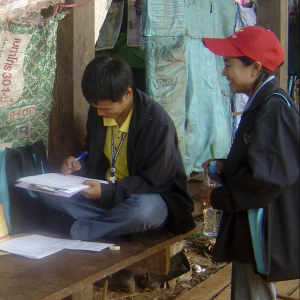To understand migration’s more complex aspects, specialized migration surveys focusing specifically on migration are preferred as they are able to capture much more detailed migration data and, if designed well, yield a larger sample of migrants. They can also collect data on migrants (and non-migrants) pertaining to the actual time of migration and not only at the time of the survey.
In the last 20 years, researchers have implemented several types of specialized migration surveys across different regions, demonstrating the advantages of this approach and improving migration research capacities.
Specialized migration surveys can help provide insights into the determinants and consequences of migration
(a) better identify migrants. Survey questions, for example, can Identify migrants according to the two main definitional criteria of change of residence and crossing a recognized international border;
(b) better study different types of migrants, such as labour migrants, family migrants, and short-term/temporary/seasonal migrants; and
(c) improve understanding of migration, for example, of the determinants and consequences of migration by asking questions that characterize the situation of the migrant and his/her household before and after migration, as well as the situations of non-migrants.
Special sampling techniques allow researchers to find more migrants and compare results better with non-migrants
In migration research, international migrants are almost always “rare” elements in a country’s population as they are usually a small proportion of the entire population so the usual methods of selecting households for interview based on random sampling rarely yield enough international migrants (especially recent migrants) (Kish, 1965). Instead of a random sample, it is desirable, if possible, to first form strata to classify places/areas in the country according to the proportions of migrants in the population (e.g., states/provinces with higher vs. lower proportions of migrants). Then those places with higher proportions of migrants are oversampled compared to those with lower proportions. In addition, in the final stages of fieldwork in selecting households to interview and not interview, two-phase sampling is very useful. It involves, first, actually visiting all the households in small clusters of 50-200 households to quickly determine (from asking any adult household member, or even a close neighbour) if the household has any former member now living abroad, to prepare a list of all households in the cluster, identifying those which do and those which do not. Then most of the former may be selected for interviews and only a few of the latter. These two procedures can yield a larger and more representative sample of international migrants, and allow researchers to better compare their situation with the rest of the population, improving understanding of both the determinants and consequences of international migration. Stratified and two-phase sampling are described in Bilsborrow et al., 1997 and Bilsborrow, 2013.
6 regional specialized migration surveys
At least six projects implemented over the past 20 years demonstrate the possibility of getting countries together in a region and/or with common interests to design and implement very similar if not identical questionnaires that can be used to collect and compare data for countries in a region, for learning about migration patterns and underlying factors, and for comparing findings across countries. These projects often yield information useful on governance practices as well.
1. The NIDI-Eurostat Push-Pulls International Migration project (1997-981
) is the first multi-country project to involve the use of specialized household migration surveys to collect data in both sending and receiving countries. Organized by the Netherlands Interdisciplinary Demographic Institute (NIDI) and EUROSTAT (Schoorl et al., 2000), it collected data to study the determinants of international migration from countries of origin to the European Union. The countries of origin were Egypt, Ghana, Morocco, Senegal and Turkey, while the countries of destination were Spain and Italy.
2. The Latin America Migration Project (LAMP) (1998 and ongoing). LAMP, which grew out of an earlier project on Mexico and began field operations in 1998 in Puerto Rico and has since used similar methods of data collection and questionnaires to collect data about international migration from eight countries to the United States. LAMP involves surveying households in communities in Latin American countries of origin (two to 14 communities) as well as sometimes conducting in-depth data interviews with migrants in the United States or other destination countries from those same origin households and communities. The communities cannot represent the country of origin but provide some breadth of experience on the effects of the emigration on the migrants, households and communities of origin. Countries who have participated as of 2018 include Colombia, Costa Rica, Dominican Republic, Ecuador, El Salvador, Haiti, Nicaragua, Paraguay and Peru.
3. The Migration from Africa to Europe (MAFE) project (2005) involved implementing surveys in households in three African countries of origin (Senegal, Ghana, and Democratic Republic of Congo), and six western European countries of destination (France, UK, Italy, Spain, Netherlands, and Belgium). Migration histories were collected—providing more details than in the other projects mentioned—allowing a fuller appreciation of the patterns, causes and consequences of African migration. Results and datasets are available online (see C. Beauchemin et al, 2013, and other publications on the MAFE website.
4. The World Bank Africa Migration Project (2008-9) was developed by the World Bank to collect data to study emigration of persons from households in six Sub-Saharan African countries (Senegal, Burkina Faso, Nigeria, South Africa, Kenya and Uganda) and the resulting remittances they received. As each country was interested also in internal migration, data were collected on both, plus in the case of South Africa, immigration. The questionnaire collected more detailed economic data than the other multi-country projects reviewed here, including household incomes/expenditures as well as remittances.
5. The Mediterranean Household International Migration Survey (MED-HIMS) project (2013 and ongoing) grew out of the European Commission’s MEDSTAT Programme in 2008 and aims “to provide analysts, policy-makers and other stakeholders with detailed information on the determinants and consequences of migration ... to help them better target migration policy and development assistance”. Pilot surveys were implemented and analyzed for the Palestinian Territory and Morocco. The first full MED-HIMS surveys were carried out in 2013 in Egypt and in 2014 in Jordan. The basic results for Egypt were released in a publication of CAPMAS in January 2016 and later updated (Farid et al., 2017), and Jordan results are in press. It is hoped that in-depth analyses will be carried out soon on Egypt and Jordan, and it is anticipated that the next national country surveys will be carried out in Morocco, Tunisia, Algeria and Lebanon in 2018-2020, depending on the availability of international funding.
Resources are needed to scale up existing survey Projects
If countries are willing to share the costs, existing regional projects on specialized migration surveys could be drawn upon and scaled up as they provide a basis for seeking a path forward towards the development of a next-generation potentially global project of specialized migration surveys2
.
Disclaimer: The opinions expressed in this blog are those of the author and do not necessarily reflect the views of the United Nations or the International Organization for Migration (IOM). The designations employed and the presentation of material throughout the blog do not imply the expression of any opinion whatsoever on the part of IOM concerning the legal status of any country, territory, city or area, or of its authorities, or concerning its frontiers and boundaries.
REFERENCES
- 1The years shown are the years of data collection in the field. Most projects involved months if not years of prior preparation as well as for subsequent data analyses and writing of reports/publications.
- 2Such a program could learn from the results and lessons of the projects above, particularly if a careful and critical assessment of the methodologies could be carried out. The above is not intended to provide an exhaustive listing of regional surveys on international migration. For example, the IOM itself has a project called the ACP Observatory on Migration examining aspects of linkages between migration and development in a number of African countries (MECLEP), and the OECD promoted the collection of comparative data to assess impacts of international migration in 10 European countries as well.





